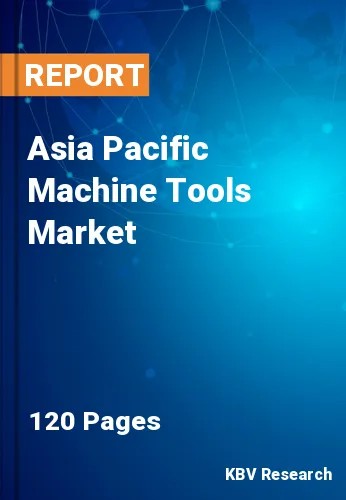The Asia Pacific Machine Tools Market would witness market growth of 4.6% CAGR during the forecast period (2021-2027).
Digital advancements and a high level of connectivity are desirable characteristics for improving factory automation. Machine performance and total equipment effectiveness can be improved by integrating sensors, using artificial intelligence (AI), and integrating complex simulation elements. In the machine tool sector, new sensors and new ways of communicating, controlling, and monitoring provide new potential for new business models and smart services. Each OEM's portfolio is about to include digitally improved offerings. The focus of a company's unique selling proposition (USP) is increasingly on digital added value.
Any stationary power-driven equipment used to shape or create pieces made of metal or other materials is referred to as a machine tool. Shapes can be achieved in four ways: cutting extra material from the component in the form of chips; shearing the material; squeezing metallic parts to the required shape; and applying electricity, ultrasonic, or corrosive chemicals to the material. The fourth category includes modern machine tools and technologies for machining ultra-hard metals that are difficult to machine using traditional methods
Most of the main machine tool makers are based in the region, which is expected to command the regional industry. China is one of the largest users of machine tools in the Asia Pacific, driving the market forward. In the Asia Pacific area, the automobile industry, oil and gas, and railways have all seen significant expansion and investment. This region is home to significant manufacturers like Yamazaki Mazak Corporation, DMG Mori, and OKUMA Corporation.
China's demand is expected to rise, boosted by strong expansion in the manufacturing sector, particularly in the precision engineering, transportation equipment, and industrial machinery industries. In addition, the market is likely to benefit from a further shift toward higher-value goods like CNC machines, machining centers, and multi-functional machines.
The China market dominated the Asia Pacific Machine Tools Market by Country 2020, and would continue to be a dominant market till 2027; thereby, achieving a market value of $10,743.9 million by 2027. The Japan market is poised to grow at a CAGR of 3.9% during (2021 - 2027). Additionally, The India market would display a CAGR of 5.2% during (2021 - 2027).
Based on Type, the market is segmented into Lathe Machines, Milling Machines, Laser Machines, Grinding Machines, Welding Machines, Winding Machines, and Others. Based on Technology, the market is segmented into Computer Numerical Control (CNC) and Conventional. Based on Sales Channel, the market is segmented into Direct and Indirect. Based on End-use, the market is segmented into Automotive, Aerospace & Defense, Construction Equipment, Power & Energy, Industrial and Others. Based on countries, the market is segmented into China, Japan, India, South Korea, Singapore, Malaysia, and Rest of Asia Pacific.
Free Valuable Insights: The Worldwide Machine Tools Market is Projected to reach USD 96.8 Billion by 2027, at a CAGR of 4%
The market research report covers the analysis of key stake holders of the market. Key companies profiled in the report include Hyundai Wia Corporation (Hyundai Motor Company), Schuler Group GmbH, CHIRON Group, JTEKT Corporation, AMADA CO., LTD., Okuma Corporation, DMG Mori Co. Ltd., Komatsu Ltd., Georg Fischer Ltd., and Makino Milling Machine Co., Ltd.
By Type
By Technology
By Sales Channel
By End-use
By Country
Our team of dedicated experts can provide you with attractive expansion opportunities for your business.

